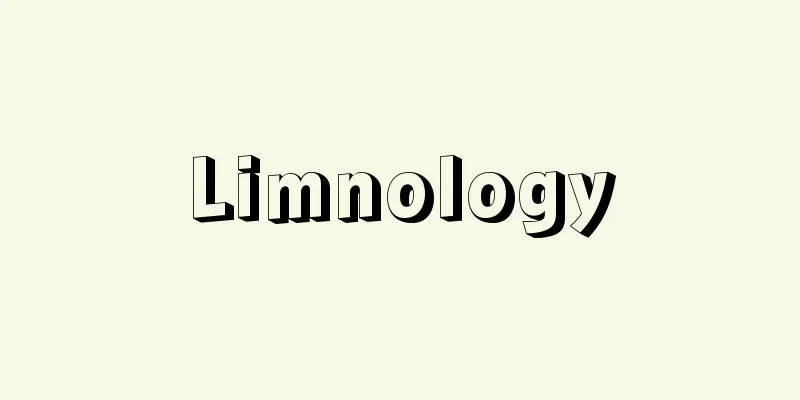Rosicrucians (English spelling) Rosenkreuzer German

|
A general term for several societies that developed a mystical movement in Germany in the early 17th century. Many societies were founded after the 17th century, modelled on the secret society founded in the 15th century by the legendary Christian Rosenkreuz (1378-1484). [Kazuhiko Hirano] The Founding and Doctrine of the Rosicrucian OrderThe Rosicrucians were founded by members who were appointed by the theologian Johann Valentin Andreae (1586-1654) and who adhered to the doctrines of theosophy and utopianism. They formed the Fraternity of Rosen (Rose) Kreuz (Cross) after their founder, Rosencreuz, and were called the "Comrades of the Rosicrucian Order," but were customarily shortened to the word "Rosicrucians." They were adepts who had achieved perfect spiritual realization, mastered science, and even attained longevity or immortality in order to serve humanity. In 1614, the Rosicrucian Manifesto, a basic document consisting of three short texts, was first published in Germany. These texts are The Fame of the Rosicrucians, The Reformation of the World, and A Short Reply to the Venerable Fraternity of the Rosicrucians (The Fame of the Rosicrucians tells of the life of Rosencreuz and the doctrine of the Rosicrucians). A second manifesto, the Confessions of the Rosicrucians, was published shortly afterwards, confessing the beliefs of the Rosicrucians. These two manifestos not only made the existence of the Rosicrucians known to the world, but also caused a great reaction that continues to this day, and a third manifesto, The Chemical Wedding of Christian Rosencreuz of 1459, was published. These texts were written by members centered around Andreae, and some are said to have been written by Andreae himself. According to the book The Fame of the Rosicrucians, the Rosicrucian Rules are: The Rosicrucians stipulate that harmony exists in all things, and that any disturbance of this is the work of the devil. They also stipulate that the correspondence between the macro and micro universes is represented by an image of a sphere, and they sought to master sacred mathematics in order to attain perfection themselves. [Kazuhiko Hirano] The origins and development of RosicrucianismThe origins of the Rosicrucians remain a mystery, although there are many hypotheses. The rose symbolizes the blood, life, and love of Christ, while the cross symbolizes Christianity itself, but there is no doubt that all of these hypotheses were formed by mixing various myths and ideas. It has been pointed out that it began with Adam and was influenced by Egyptian, Indian, and Arabic ideas. Particularly strong influences are said to have been Gnosticism, which claims to attain esoteric ultimate knowledge and salvation, Kabbalah, an esoteric and symbolic Jewish interpretation of the Bible text, Hermetic thought related to alchemy, and, more broadly, medieval and Protestant mysticism. This secret society, originally called Rosenkreuz, attracted many adherents, more or less devoted to the ideals of world peace, purity cults, material and spiritual alchemy, and revelation, and took shape in Germany in the 17th century and in England and France in the 19th century. In Germany, the movement expanded from 1777 onwards, centering around the "Ancient Golden Rosicrucians" founded in Berlin. In 1888, the pastor Samuel Richter founded the "Golden Rosicrucians", which placed emphasis on alchemy. This order later became associated with Freemasonry and even the legend of the Knights Templar. In London, England, the "British Rosicrucian Society" was founded around 1866, inspired by the Ancient Golden Rosicrucians. Two of its members, Samuel Liddell MacGregor Mathers (1854-1918) and William Wynn Westcott (1848-1925), split off from it and founded the "Order of the Golden Dawn". In France, Stanislas de Guaita (1861-97) founded the Rosicrucian Cabalistic Order in 1888, and two years later Josephin Péladan (1859-1918) separated from it to form the Cathedral Rosicrucian Order, or Catholic Rosicrucian Order. In the 20th century, Spencer H. Lewis (1883-1939) founded the Ancient Mystical Order of Rosicrucians (AMORC) in the United States in 1909. The Danish Max Heindel (1865-1919) organized the Society of Rosicrucians in 1911. Meanwhile, in the Netherlands, a group called the Rosicrucian Readers tried to return to the original Rosicrucian doctrine. [Kazuhiko Hirano] Influence of Rosicrucian ideasMany philosophers and literary figures were connected to the Rosicrucians or influenced by their ideas. The most prominent of these was Goethe, who wrote "Faust." Others from Germany include Jung Stilling and Stephan George, and Austria's Hofmannsthal. Mozart is also inseparable from the Rosicrucians. In England, he had a strong influence on Francis Bacon, and in France, on Descartes. Erik Satie also composed a piano piece, "The Bells of the Rosicrucians," for the "Catholic Rosicrucians" in 1892. [Kazuhiko Hirano] "The Rosicrucians" by R. Edigofer, translated by Yoshihiro Tanaka (Hakusuisha, Que sais-je Bunko)" ▽ "The Awakening of the Rosicrucians - The Hidden History of the European Spirit, by Frances A. Yates, translated by Tomoo Yamashita (1986, Kousakusha)" ▽ "The Symbolic Philosophy Series 3: Kabbalah and the Rosicrucians, by Manly P. Hall, translated by Tadahiro Onuma et al. (1981, Jinbun Shoin)" ▽ "The Rosicrucians" by C. Mackintosh, translated by Masakazu Yoshimura (1990, Heibonsha)" ▽ "The Magic of the Rosicrucians, by Toshihiro Tanemura (Kawade Bunko)" ▽ "The Theosophy of the Rosicrucians, by R. Steiner, translated by Takanori Nishikawa (1985, Heikawa Publishing)" [References] | | | | | | | |Hermes |Source: Shogakukan Encyclopedia Nipponica About Encyclopedia Nipponica Information | Legend |
|
17世紀初頭、ドイツにおいて神秘主義的な運動を展開した複数の結社の総称。15世紀に伝説的人物クリスチャン・ローゼンクロイツChristian Rosenkreuz(1378―1484)によって創設された秘密結社をモデルとして、17世紀以降多くの会が創設された。 [平野和彦] 薔薇十字団の創設と教義「薔薇十字団」は神学者ヨハン・バレンティン・アンドレーエJohann Valentin Andreae(1586―1654)によって指名された、神智学とユートピア思想の教義を奉ずるメンバーによって創設された。彼らは始祖ローゼンクロイツの名にちなんで「Rosen(薔薇)Kreuz(十字)友愛団」を結成、「薔薇十字団の同志」とよばれたが、習慣的に「薔薇十字団」と略称された。彼らは、人類に仕えるために、完全な精神の実現を達成し、科学を極め、さらに長寿あるいは不滅に到達したとされる達人たちであった。 1614年、ドイツで三つの短いテクストからなる基本文書、「薔薇十字団宣言」が初めて世に出された。そのテクストとは『薔薇十字団の名声』『世界の改革』『尊敬すべき薔薇十字友愛団への短い返答』である(『薔薇十字団の名声』では、ローゼンクロイツの生涯、薔薇十字団の教義が語られている)。その後、薔薇十字団の信条を告白する二つ目の宣言『薔薇十字団の告白』も出された。これらの二つの宣言のテクストは薔薇十字団の存在を世に知らしめると同時に、現代にまでつながるほどの大きな反響を呼びおこし、さらに第三の宣言として『1459年のクリスチャン・ローゼンクロイツの化学の結婚』が出された。これらのテクストは、アンドレーエを中心とするメンバーによるもので、一部アンドレーエ個人の著作とされている。 『薔薇十字団の名声』によれば、薔薇十字団の規則は、 薔薇十字団は、万物には調和が存在し、それが乱されるのは悪魔によるものだと規定する。また、マクロとミクロの両宇宙の照応は球によるイメージで表され、その完全性を自ら達成するために、神聖なる数学を究めようとした。 [平野和彦] 薔薇十字団の淵源と展開薔薇十字団の淵源(えんげん)に関しては、いくつもの仮説がたてられてはいるが、依然として不明である。薔薇はキリストの血、生命、愛を象徴し、十字架はキリスト教そのものを象徴するなどとされているが、これらの仮説はいずれも、さまざまな神話や思想が混合されて形成されていったことは間違いない。それはアダムに始まり、エジプト、インド、アラビアの思想の影響まで指摘されている。とくに強い影響を与えているといわれているのは、秘教的究極の知を得て救済に至るというグノーシス、秘教的、象徴的ユダヤ教による聖書テクストの解釈であるカバラ、錬金術と関連するヘルメス思想、そして大きくいえば中世とプロテスタントの神秘主義である。 当初ローゼンクロイツの名でよばれたこの秘密結社に、多くの信者が集まった。彼らは多かれ少なかれ世界の平和、純粋カルト(狂信性をもつ宗教集団)、物質的・精神的錬金術、啓示の理想に忠実な人々であり、前述のごとく17世紀のドイツで、また19世紀にはイギリスとフランスで、その実体をもつことになった。 ドイツでは、さらに1777年以降、ベルリンで結成された「古式黄金薔薇十字団」が中心となって、その運動を拡大していった。また1888年、牧師ザミュエル・リヒターSamuel Richterによって、錬金術が優位にたつ「黄金薔薇十字団」が設立された。この会は後にフリーメーソンと結びつき、さらにはテンプル騎士団(テンプル騎士修道会)の伝説とも結びついた。イギリスのロンドンでは、1866年ごろ、古式黄金薔薇十字団からインスピレーションを受けて、「英国薔薇十字協会」が設立された。そのメンバーのうちの二人、マクレガーSamuel Liddell MacGregor Mathers(1854―1918)とウェスコットWilliam Wynn Westcott(1848―1925)がそこから分かれて「黄金の夜明け団」を創設。フランスでは、1888年にスタニスラス・ド・ガイタStanislas de Guaita(1861―97)が「薔薇十字カバラ団」を創設、2年後ジョゼファン・ペラダンJoséphin Péladan(1859―1918)がここから独立分離して、「聖堂聖杯薔薇十字団」あるいは「カトリック薔薇十字団」を組織した。 20世紀になって、アメリカ合衆国では1909年にスペンサー・ルイスSpencer H.Lewis(1883―1939)が「古代神秘薔薇十字団」(AMORC)を設立。デンマーク人のマックス・ハインデルMax Heindel(1865―1919)は、「薔薇十字協会」を組織した(1911)。一方オランダでは「薔薇十字の朗読者」というグループが、最初の薔薇十字団の教義に戻ろうという動きをみせた。 [平野和彦] 薔薇十字団の思想の影響薔薇十字団に関係した、あるいはその思想に影響を受けた哲学者や文学者は多い。その筆頭が『ファウスト』を書いたゲーテ。同じドイツではユング・シュティリング、シュテファン・ゲオルゲ、オーストリアのホフマンスタールらがいる。モーツァルトも薔薇十字団とは切り離せない。イギリスではとくにフランシス・ベーコン、フランスではデカルトに強い影響を与えた。また、エリック・サティは1892年に「カトリック・バラ十字団」のためにピアノ曲『バラ十字団の鐘』を作曲している。 [平野和彦] 『R・エディゴフェル著、田中義廣訳『薔薇十字団』(白水社・文庫クセジュ)』▽『フランセス・A・イエイツ著、山下知夫訳『薔薇十字の覚醒――隠されたヨーロッパ精神史』(1986・工作舎)』▽『マンリー・P・ホール著、大沼忠弘他訳『象徴哲学大系3 カバラと薔薇十字団』(1981・人文書院)』▽『C・マッキントッシュ著、吉村正和訳『薔薇十字団』(1990・平凡社)』▽『種村季弘著『薔薇十字の魔法』(河出文庫)』▽『R・シュタイナー著、西川隆範訳『薔薇十字会の神智学』(1985・平河出版社)』 [参照項目] | | | | | | | | |出典 小学館 日本大百科全書(ニッポニカ)日本大百科全書(ニッポニカ)について 情報 | 凡例 |
Recommend
Hemostatic drug - Hemostatic
This refers to drugs that stop or prevent bleedin...
Sinbad
A wealthy merchant from Baghdad who appears in the...
Polwarth
…Typical breeds include the Corriedale (illustrat...
False fruit
A pseudocarp is a general term for fruits that in...
Hirohata
A district of Himeji City in southern Hyogo Prefe...
Place crack - Place crack
Hydrogen embrittlement is a process that occurs w...
Kamiakizuki
...A city in central Fukuoka Prefecture. In 1954,...
Hector Guimard
A representative French Art Nouveau architect. Bo...
Atash Kadeh - Atash Kadeh
… There are about 50 known Zoroastrian fire templ...
Aso Sea
A lagoon in northern Kyoto Prefecture. It is also...
Demon God - Kishin
It refers to the souls of the dead enshrined as g...
Azores high pressure - Azores high pressure
A large-scale high pressure system that appears in...
LOHAS - LOHAS
A lifestyle that emphasizes health and environmen...
Gulliver-type oligopoly - Gulliver is the winner
The term "oligopoly" refers to a situati...
"American Night - With Love in the Movies" - American Night
...American film actress. Described as "the ...









